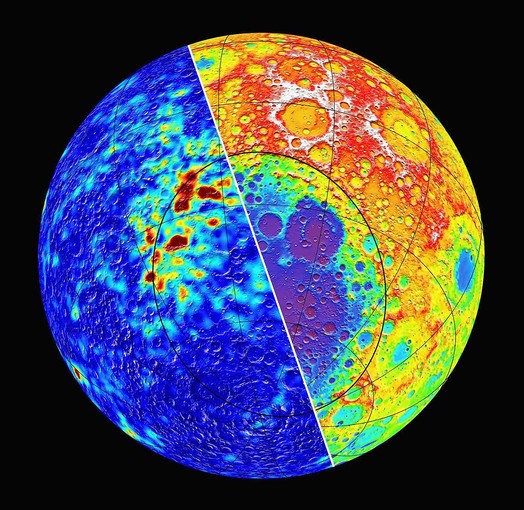New Scientist | Astrophile | MacGregor Campbell | 2012 Mar 09
Object type: Space rock
Size: 200 kilometres wide
A rock five times the width of London hurtles through space. Destination? The south pole on the far side of the moon. As it strikes, it turns the surface into a brilliant sea of molten rock. In a flash, the rock's metal-rich body melts too, and a molten mixture of both it and the moon sprays upwards into the blackness of space.
Most falls back down near the impact site, some vaporises into clouds of plasma, and some rains down as far away as the opposite pole.
When the chaos settles, the moon is forever changed. It bears a scar on its surface larger than any other in the solar system. And now it seems the splattered remains of the visitor can explain one of the moon's biggest mysteries: why only certain regions of the crust are magnetised.
Evidence for the giant impact went unnoticed until the 1960s, when the first lunar orbiters got a look at the moon's far side. There, they saw the mammoth South Pole-Aitken basin. The biggest crater known, it stretches across a quarter of the entire lunar circumference.
Soon afterwards, Apollo astronauts brought samples of the lunar crust back to Earth and found a surprise – they were magnetised. Even though the moon has no global magnetic field today, this suggested that molten metal – an electrically conducting fluid – once sloshed around the moon's core forcefully enough to generate one in the past.
'Fairy dust'
Subsequent orbiter missions mapped the magnetised regions of the crust and found that instead of being uniformly distributed across the surface – as might be expected if the moon had an internally-generated magnetic field – their distribution is splotchy. Hundreds of magnetised regions, most on the far side, are surrounded by vast deserts of crust with little or no magnetism.
"The fact that [the moon is] generating these anomalous magnetic fields seems difficult to account for unless there's some sort of exotic fairy dust that's been sprinkled on it," says Ben Weiss at the Massachusetts Institute of Technology.
It makes sense that most of the moon would be unmagnetised. The crust is composed largely of anorthosite, a rare rock on Earth that forms when light, aluminium-rich minerals float to the top of a lava pool. Other metals, such as iron, are magnetised much more easily, but these heavier elements are thought to have sunken to the centre of the moon early in its formation, when our satellite was still molten after its creation in a collision between Earth and a Mars-sized object.
Space rocks, on the other hand, contain more of the heavy metals throughout their bodies because most never got hot enough to melt and differentiate into layers of different density.
Now Mark Wieczorek of Paris Diderot University in France, along with Weiss and colleagues, says the moon's magnetic fairy dust comes from the 200-kilometre-wide space rock that gouged out the South Pole-Aitken basin.
On the edge
Its mass was comparable to all of the other meteoroids that have hit the moon – combined. "That thing brought in a lot of material," says Weiss.
The team's computer simulations show that the molten ejecta from the impact should have fallen where the magnetic anomalies are found. "[Most] are sitting on the edge of the largest impact crater in the solar system," Weiss says.
So the giant space rock explains the source of magnetisable material. The strength of the magnetism recorded suggests that the impact occurred early in the moon's history, before the moon cooled and lost its internal magnetic field. That allowed the metal atoms in the molten metal-rock mixture to line up like bar magnets. Testing this idea will require bringing back samples of rocks from the South Pole-Aitken basin to determine when the impact occurred, Weiss says.
Catherine Johnson at the University of British Columbia in Vancouver, Canada, who was not involved with the research, says the theory is much simpler than previous explanations, some of which involved clouds of plasma travelling around the moon after a series of smaller impacts on the lunar near side. "You need everything to happen just so [with those explanations]," she says.
Gareth Collins, of Imperial College London in the UK, says the magnetised metallic rocks on South Pole-Aitken basin's rim might be a good target for future human exploration. "It could prove an invaluable resource for human colonisation of the moon," he says.
Moonstruck Magnetism - Gareth S. Collins
- Science 335(6073) 1176 (09 Mar 2012) DOI: 10.1126/science.1217681
- Science 335(6073) 1212 (09 Mar 2012) DOI: 10.1126/science.1214773
Magnetism on the Moon
Harvard University | Peter Reuell | 2012 Mar 12
Asteroids May Have Delivered Magnetic Material to the Moon
NASA Lunar Science Institute | 2012 Mar 12
<< Previous Astrophile
